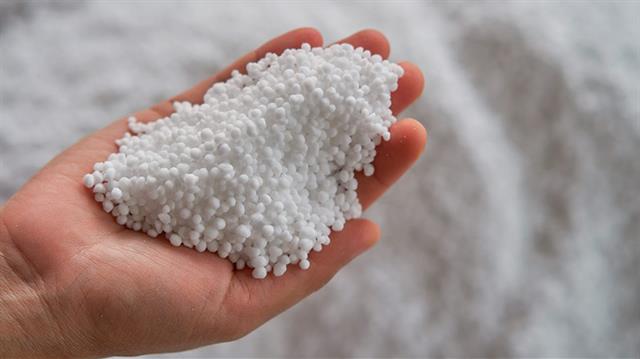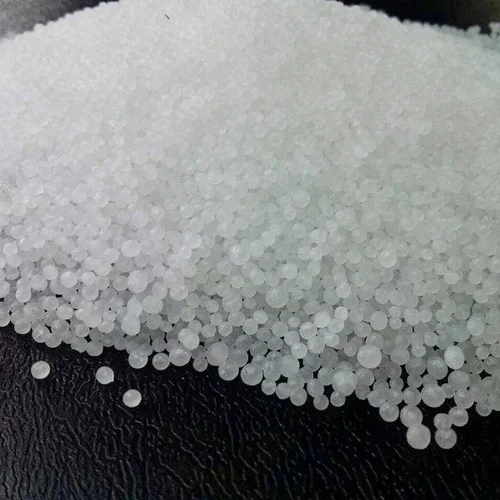Prilled urea is a solid form of urea that is widely used as a nitrogen-based fertilizer in agriculture. It’s created by spraying molten urea into a prilling tower, where the droplets cool and solidify into small, rounded granules or “prills.” This prilled form has several specific characteristics that make it suitable for certain agricultural and industrial applications.
Manufacturing Process:
Prilled urea is produced through a process called prilling, which involves:
- Melting urea: Urea is first heated until it becomes a molten liquid.
- Spraying in prilling tower: The molten urea is sprayed from the top of a prilling tower. As the urea droplets fall through the tower, they cool, solidify, and form small, spherical particles known as prills.
- Cooling: The tower is typically cooled by air, causing the molten urea droplets to solidify quickly into prills before they reach the bottom.
This method produces urea particles that are smaller and lighter compared to granulated urea, which undergoes a different process
Chemical Properties:
- Nitrogen content: Prilled urea is composed of 46% nitrogen, making it a highly concentrated nitrogen source. This makes it a cost-effective fertilizer since a small amount can supply a large amount of nitrogen to crops.
- Solubility: Urea is highly water-soluble, meaning prilled urea dissolves quickly when applied to soil or mixed with irrigation water, allowing nitrogen to become available to plants relatively fast.
- Volatilization: Urea can undergo a process called ammonia volatilization, especially when left on the soil surface without being incorporated. This results in the loss of nitrogen to the atmosphere, reducing the fertilizer’s effectiveness. This is more pronounced in certain soil types and climates.
Agricultural Applications:
- Fertilizer: Prilled urea is primarily used as a nitrogen fertilizer for crops. Nitrogen is essential for plant growth as it is a major component of chlorophyll (necessary for photosynthesis) and amino acids (building blocks of proteins).
- Application methods:
- Broadcast application: Prilled urea can be spread over fields using broadcasting equipment. It should be incorporated into the soil soon after application to reduce nitrogen loss.
- Fertigation: Due to its solubility, prilled urea can be dissolved in irrigation water and applied through fertigation systems, making it suitable for drip irrigation or sprinkler systems.
- Crops: It’s used on a variety of crops, including cereals (wheat, corn), vegetables, fruits, and even in pastures for grazing animals.
However, due to its smaller size and lighter weight, prilled urea may not spread as evenly as granular urea, making it more prone to drifting in windy conditions.

Industrial Applications:
Beyond agriculture, prilled urea is used in several industries:
- Resin and adhesives production: Urea is a key raw material in the production of urea-formaldehyde resins, commonly used in the manufacturing of particleboards, plywood, and other wood products.
- Diesel Exhaust Fluid (DEF): Urea is an essential component in DEF, a solution used in selective catalytic reduction (SCR) systems to reduce NOx emissions from diesel engines. When sprayed into the exhaust stream, it helps break down nitrogen oxides into harmless nitrogen and water vapor.
- Chemicals: Urea is also used in the production of melamine, another important industrial compound, and in various chemical processes that require nitrogen sources.
- Explosives: In combination with other chemicals, urea can be used in the production of certain types of industrial explosives.
Comparison with Granular Urea:
- Size and Shape: Prilled urea consists of smaller, round prills, while granular urea is larger and more robust. Granular urea tends to be harder and more resistant to degradation during handling and storage, while prilled urea can be more prone to dusting or breakage.
- Spreading and application: Granular urea is typically preferred when precise application is needed because it spreads more evenly over larger areas due to its size and weight. Prilled urea, being lighter, may not spread as uniformly and is more affected by environmental conditions like wind.
- Dissolution rate: Prilled urea generally dissolves faster than granular urea, which can be an advantage when quick nitrogen release is needed. However, this also means that it is more susceptible to volatilization, leading to nitrogen loss if not incorporated into the soil promptly.
- Handling and storage: Prilled urea is more hygroscopic, meaning it has a higher tendency to absorb moisture from the air. If not stored properly in dry conditions, it can clump together and degrade, affecting its quality and effectiveness.
Storage and Handling:
- Moisture sensitivity: Prilled urea can absorb moisture from the air, leading to caking or clumping. This can reduce its effectiveness as a fertilizer and complicate its application. For this reason, it’s important to store prilled urea in sealed, moisture-resistant bags or in dry storage facilities to prevent degradation.
- Dust: The smaller particles and lighter nature of prilled urea mean it can generate more dust during handling compared to granular urea. This can pose some handling challenges, especially in large-scale agricultural operations.
Environmental Considerations:
- Nitrogen loss: As mentioned earlier, prilled urea is prone to nitrogen loss through volatilization if it’s not properly incorporated into the soil after application. In humid or high-pH environments, nitrogen loss can be significant, reducing the fertilizer’s efficiency.
- Leaching: In sandy soils or areas with high rainfall, nitrogen from urea can leach into the groundwater, contributing to water pollution and eutrophication of water bodies.
Enhancements:
To improve the effectiveness of prill urea, certain products are coated with urease inhibitors or nitrification inhibitors to slow down the conversion of urea into ammonia or nitrate, reducing volatilization and leaching, and thereby increasing nitrogen uptake by plants.
Conclusion:
Prill urea remains a popular form of nitrogen fertilizer due to its high nitrogen content, cost-effectiveness, and ease of application. Its quick dissolution makes it suitable for certain crops and situations, but it also requires careful handling and storage to avoid moisture-related degradation. In comparison to granular urea, prilled urea offers faster nitrogen release but may be less durable and precise in large-scale field applications.
(FAQ)
What is prilled urea used for?
- Agriculture: Prill urea is primarily used as a nitrogen fertilizer to promote plant growth. It is applied to a wide range of crops, including cereals, vegetables, and fruits.
- Industrial use: It is also used in the production of resins, adhesives, melamine, and as a key ingredient in Diesel Exhaust Fluid (DEF) to reduce nitrogen oxide emissions from diesel engines.
How should prilled urea be stored?
Prill urea should be stored in a cool, dry environment. It is hygroscopic, meaning it absorbs moisture from the air, which can lead to clumping or caking. It is best to store it in moisture-resistant bags and in well-ventilated, dry storage facilities to preserve its quality.
Can prilled urea be used in organic farming?
No, prill urea is a synthetic fertilizer and is not permitted in certified organic farming systems. Organic farming relies on natural nitrogen sources, such as compost, manure, or legume crops that fix nitrogen from the atmosphere.
What is the nitrogen content of prilled urea?
Prilled urea contains approximately 46% nitrogen, making it one of the most concentrated nitrogen fertilizers available. This high nitrogen content makes it cost-effective since a smaller amount can supply a large quantity of nitrogen to crops.
Can prilled urea be mixed with other fertilizers?
Prill urea can be blended with other dry fertilizers, but it is important to avoid mixing it with materials like ammonium nitrate or superphosphate under humid conditions. Urea can absorb moisture and cause the mixture to cake or clump, reducing its spreadability and effectiveness.
How long does prilled urea last in storage?
If stored in dry, cool conditions and in sealed bags, prilled urea can last for an extended period without significant degradation. However, exposure to moisture can cause it to cake or clump, reducing its effectiveness. Proper storage can ensure a shelf life of several months to years.
How does prilled urea impact soil pH?
When urea breaks down in the soil, it temporarily increases the pH (making it more alkaline). However, over time, as urea is converted into ammonium and then nitrate, it can contribute to acidification of the soil, especially when used in large quantities over time.
How quickly does prilled urea release nitrogen into the soil?
Prill urea dissolves quickly once in contact with moisture. After application, nitrogen is available to plants within a few days as the urea converts into ammonium and nitrate. However, the exact release speed depends on soil temperature, moisture, and microbial activity.
